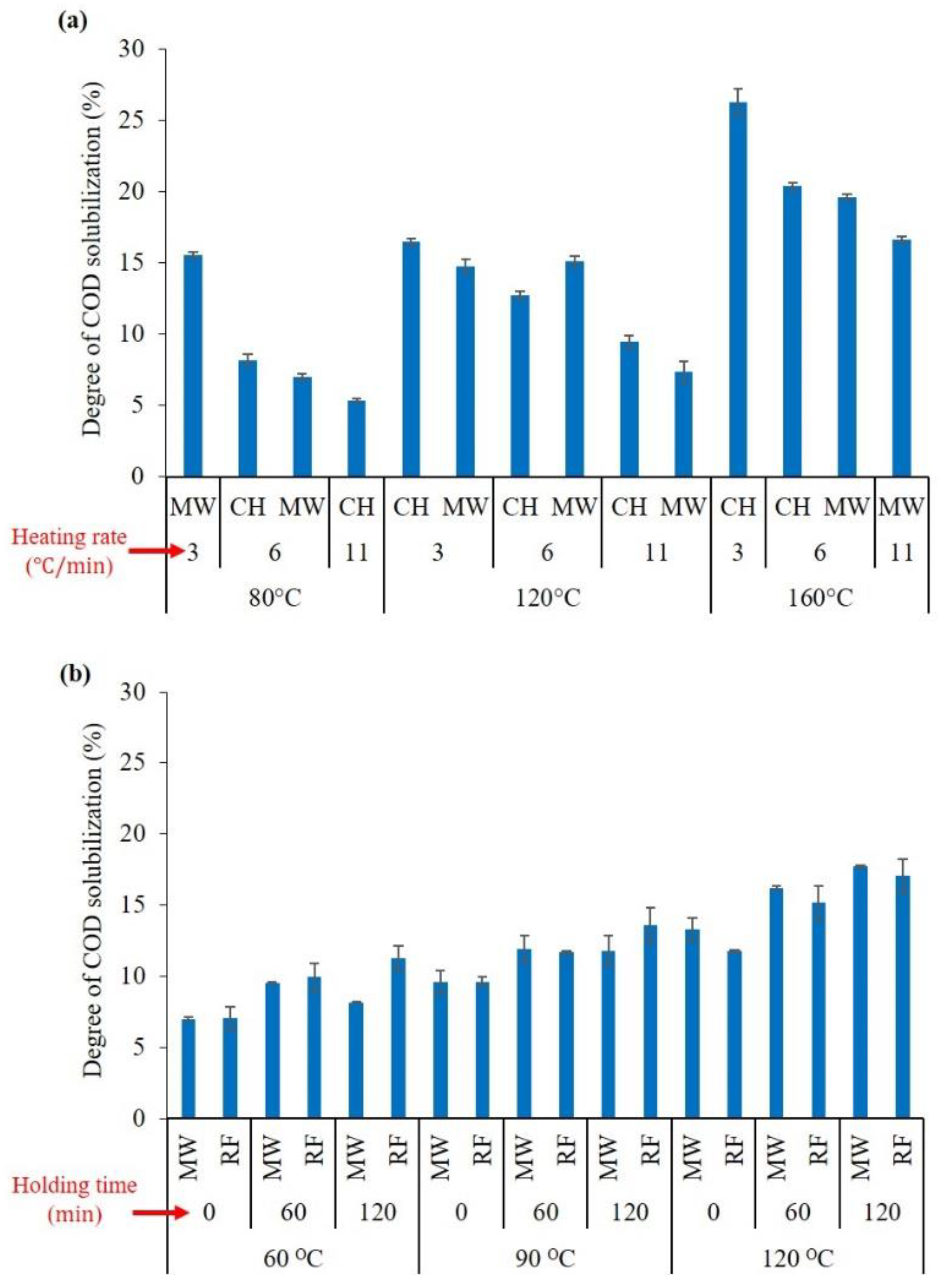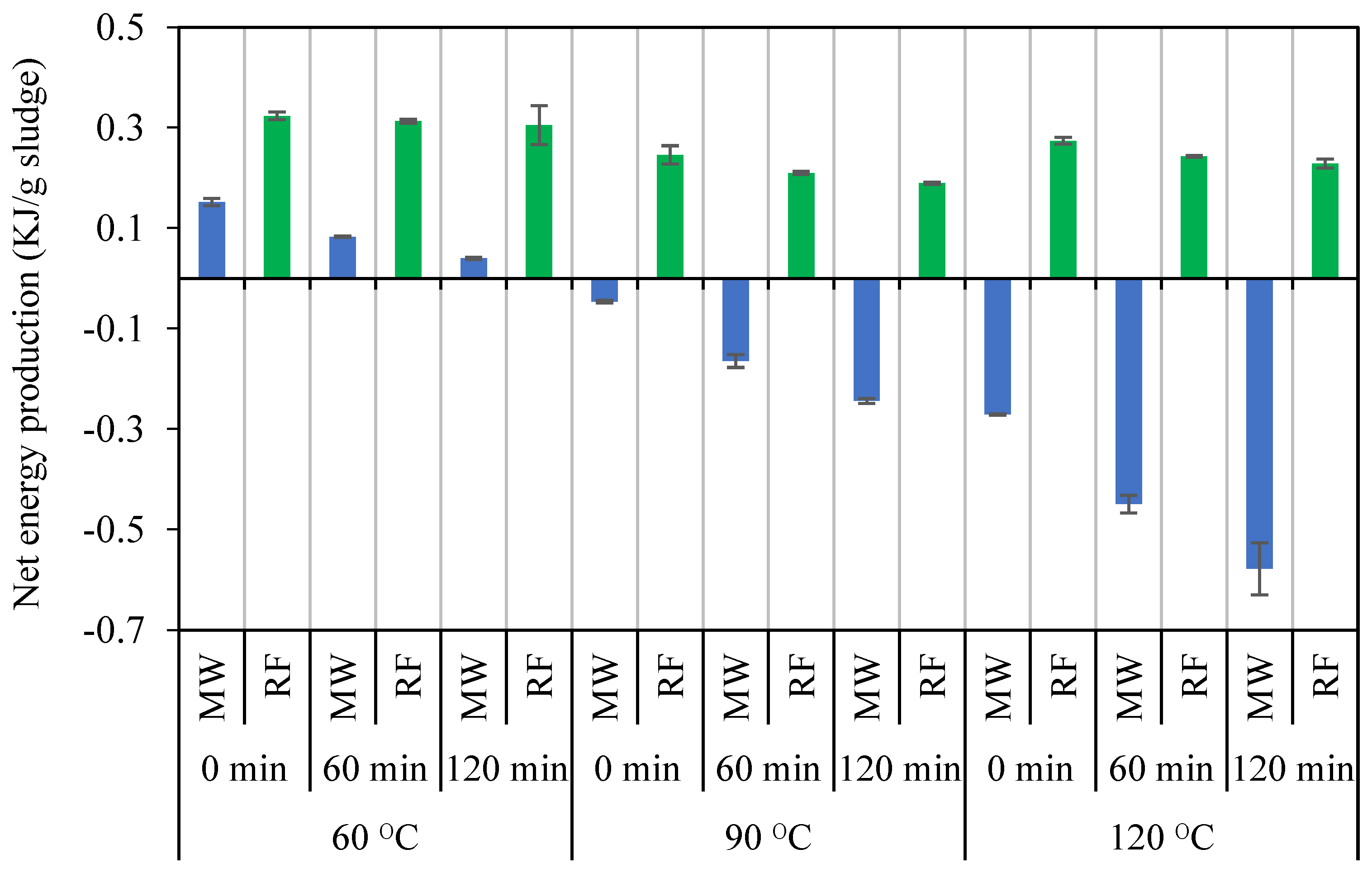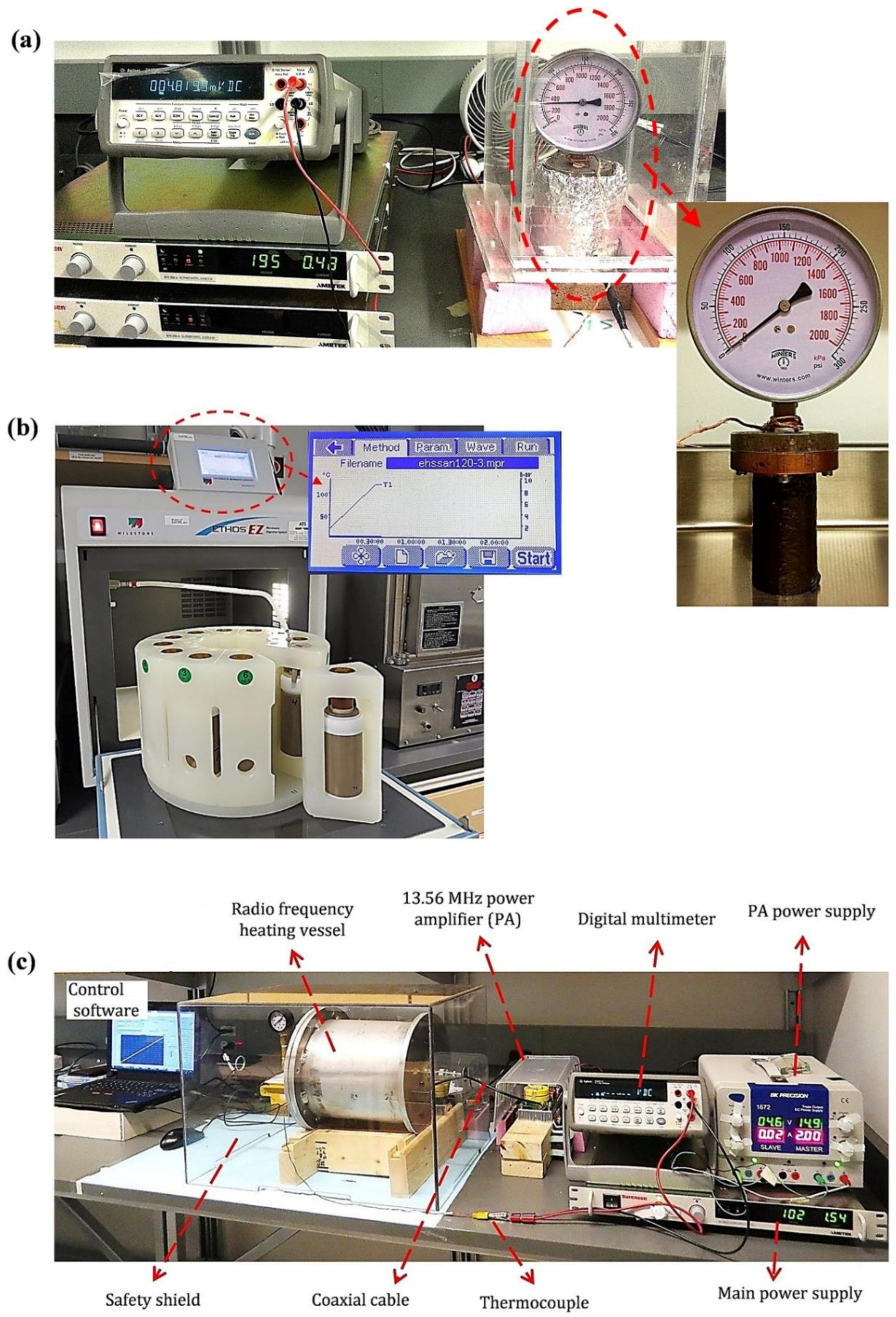Comparison of Different Electricity-Based Thermal Pretreatment Methods for Enhanced Bioenergy Production from Municipal Sludge
Abstract
:1. Introduction
2. Results and Discussion
2.1. Comparison of CH, MW, and RF Pretreatments for Sludge Disintegration
2.2. Comparison of CH, MW, and RF Pretreatments for Bioenergy Production
3. Materials and Methods
3.1. Municipal Sludge Characteristics
3.2. Thermal Pretreatment Systems
3.2.1. CH Pretreatment System
3.2.2. MW Pretreatment System
3.2.3. RF Pretreatment System
3.3. Experimental Design
3.3.1. CH vs. MW Comparison
3.3.2. MW vs. RF Comparison
3.4. Sludge Disintegration Study
3.5. Anaerobic Digestion Study
3.6. Energy Analysis
3.7. Analytical Method
3.8. Statistical Analysis
4. Conclusions
Author Contributions
Funding
Acknowledgments
Conflicts of Interest
References
- Spinosa, L.; Vesilind, P.A. Sludge into Biosolids: Processing, Disposal and Utilization; IWA Publishing: London, UK, 2001. [Google Scholar]
- Biosolids Generation, Use and Disposal in the United States; EPA530-R-99-009; U.S. Environmental Protection Agency, Municipal and Industrial Solid Waste Division, Office of Solid Waste: Washington, DC, USA, 1999.
- Pe´rez-Elvira, S.I.; Nieto Diez, P.; Fdz-Polanco, F. Sludge minimisation technologies. Rev. Environ. Sci. Bio/Technol. 2006, 5, 375–398. [Google Scholar] [CrossRef]
- Appels, L.; Baeyens, J.; Degre’ve, J.; Dewil, R. Principles and potential of the anaerobic digestion of waste-activated sludge. Prog. Energy Combust. Sci. 2008, 34, 755–781. [Google Scholar] [CrossRef]
- Metcalf; Eddy, Wastewater Engineering: Treatment and Reuse, 5th ed.; McGraw-Hill: New York, NY, USA, 2013.
- Tyagi, V.K.; Lo, S.-L. Microwave irradiation: A sustainable way for sludge treatment and resource recovery. Renew. Sust. Energy. Rev. 2013, 18, 288–305. [Google Scholar] [CrossRef]
- Park, W.J.; Ahn, J.H. Optimization of microwave pretreatment conditions to maximize methane production and methane yield in mesophilic anaerobic sludge digestion. Environ. Technol. 2011, 32, 1533–1540. [Google Scholar] [CrossRef] [PubMed]
- Mehdizadeh, N.S.; Eskicioglu, C.; Bobowski, J.; Johnson, T. Conductive heating and microwave hydrolysis under identical heating profiles for advanced anaerobic digestion of municipal sludge. Water Res. 2013, 47, 5040–5051. [Google Scholar] [CrossRef] [PubMed]
- Sólyom, K.; Mato, R.B.; Pérez-Elvira, S.I.; Cocero, M.J. The influence of the energy absorbed from microwave pretreatment on biogas production from secondary wastewater sludge. Bioresour. Technol. 2011, 102, 10849–10854. [Google Scholar] [CrossRef] [PubMed]
- Appels, L.; Degrève, J.; Van der Bruggen, B.; Van Impe, J.; Dewil, R. Influence of low temperature thermal pre-treatment on sludge solubilisation, heavy metal release and anaerobic digestion. Bioresour. Technol. 2010, 101, 5743–5748. [Google Scholar] [CrossRef] [PubMed]
- Eskicioglu, C.; Kennedy, K.J.; droste, R.L. Characterization of soluble organic matter of waste activated sludge before and after thermal pretreatment. Water Res. 2006, 40, 3725–3736. [Google Scholar] [CrossRef] [PubMed]
- Incropera, F.P.; DeWitt, D.P.; Bergman, T.L.; Lavine, A.S. Introduction to Heat Transfer; John Wiley & Sons, Inc.: Hoboken, NJ, USA, 2007. [Google Scholar]
- Climent, M.; Ferrer, I.; Mar Baeza, M.; Artola, A.; Vazquez, F.; Font, X. Effects of thermal and mechanical pretreatments of secondary sludge on biogas production under thermophilic conditions. Chem. Eng. J. 2007, 133, 335–342. [Google Scholar] [CrossRef]
- Park, W.; Ahn, J. Effects of microwave pretreatment on mesophilic anaerobic digestion for mixture of primary and secondary sludges compared with thermal pretreatment. Environ. Eng. Res. 2011, 16, 103–109. [Google Scholar] [CrossRef]
- Pino-Jelcic, S.A.; Hong, S.; Park, J.K. Enhanced anaerobic biodegradability and inactivation of fecal coliforms and Salmonella spp. in wastewater sludge by using microwaves. Water Environ. Res. 2006, 78, 209–216. [Google Scholar] [CrossRef] [PubMed]
- Koupaie, E.H.; Johnson, T.; Eskicioglu, C. Advanced anaerobic digestion of municipal sludge using a novel and energy-efficient radio frequency pretreatment system. Water Res. 2017, 118, 70–81. [Google Scholar] [CrossRef] [PubMed]
- Eskicioglu, C.; Terzian, N.; Kennedy, K.J.; Droste, R.L.; Hamoda, M. Athermal microwave effects for enhancing digestibility of waste activated sludge. Water Res. 2007, 41, 2457–2466. [Google Scholar] [CrossRef] [PubMed]
- Beszédes, S.; László, Z.; Szabó, G.; Hodúr, C. Examination of the effect of microwave heating on the biodegradable and soluble fraction of organic matter of sludge. J. Eng. Ann. Fac. Eng. Hunedoara 2009, 7, 87–90. [Google Scholar]
- Beszédes, S.; László, Z.; Horváth, Z.H.; Szabó, G.; Hodúr, C. Comparison of the effects of microwave irradiation with different intensities on the biodegradability of sludge from the dairy- and meat-industry. Bioresour. Technol. 2011, 102, 814–821. [Google Scholar] [CrossRef] [PubMed]
- Hong, S.M.; Park, J.K.; Lee, Y.O. Mechanism of microwave irradiation involved in the destruction of fecal coliforms from biosolids. Water Res. 2004, 38, 1615–1625. [Google Scholar] [CrossRef] [PubMed]
- Kuglarz, M.; Karakashev, D.; Angelidaki, I. Microwave and thermal pretreatment as methods for increasing the biogas potential of secondary sludge from municipal wastewater treatment plants. Bioresour. Technol. 2013, 134, 290–297. [Google Scholar] [CrossRef] [PubMed]
- Hosseini Koupaie, E.; Eskicioglu, C. Below and above boiling point comparison of microwave irradiation and conductive heating for municipal sludge digestion under identical heating/cooling profiles. Bioresour. Technol. 2015, 187, 235–245. [Google Scholar] [CrossRef] [PubMed]
- Hosseini Koupaie, E.; Eskicioglu, C. Conventional heating vs. microwave sludge pretreatment comparison under identical heating/cooling profiles for thermophilic advanced anaerobic digestion. Waste Manag. 2016, 53, 182–195. [Google Scholar] [CrossRef] [PubMed]
- Eskicioglu, C.; Kennedy, K.J.; Droste, R.L. Initial examination of microwave pretreatment on primary, secondary and mixed sludges before and after anaerobic digestion. Water Sci. Technol. 2008, 57, 311–317. [Google Scholar] [CrossRef] [PubMed]
- Ji Park, W.; Ahn, J.-H.; Hwang, S.; Lee, C.-K. Effect of output power, target temperature, and solid concentration on the solubilization of waste activated sludge using microwave irradiation. Bioresour. Technol. 2010, 101, 13–16. [Google Scholar] [CrossRef] [PubMed]
- Park, W.; Ahn, J.; Lee, C. Effect of temperature-increase rate and terminal temperature on the solubilization of sewage sludge using microwave irradiation. Environ. Eng. Res. 2009, 14, 48–52. [Google Scholar] [CrossRef]
- Toreci, I.; Kennedy, K.J.; Droste, R.L. Effect of high-temperature microwave irradiation on municipal thickened waste activated sludge solubilization. Heat Trans. Eng. 2011, 31, 766–773. [Google Scholar] [CrossRef]
- Vergine, P.; Zábranská, J.; Canziani, R. Low temperature microwave and conventional heating pre-treatments to improve sludge anaerobic biodegradability. Water Sci. Technol. 2014, 69, 518–524. [Google Scholar] [CrossRef] [PubMed]
- Wanner, O.; Panagiotidis, V.; Clavadetscher, P.; Siegrist, H. Effect of heat recovery from raw wastewater on nitrification and nitrogen removal in activated sludge plants. Water Res. 2005, 39, 4725–4734. [Google Scholar] [CrossRef] [PubMed]
- Gasafi, E.; Reinecke, M.-Y.; Kruse, A.; Schebek, L. Economic analysis of sewage sludge gasification in super critical water forhydrogen production. Biomass Bioenergy 2008, 32, 1085–1096. [Google Scholar] [CrossRef]
- Akgul, D.; Cella, M.A.; Eskicioglu, C. Influences of low-energy input microwave and ultrasonic pretreatments on single-stage and temperature-phased anaerobic digestion (TPAD) of municipal wastewater sludge. Energy 2017, 123, 271–282. [Google Scholar] [CrossRef]
- Lu, J.; Gavala, H.N.; Skiadas, I.; Mladenovska, Z.; Ahring, B. Improving anaerobic sewage sludge digestion by implementation of a hyperthermophilic prehydrolisis step. J. Environ. Manag. 2008, 88, 881–889. [Google Scholar] [CrossRef] [PubMed]
- Neyens, E.; Baeyens, J. A review of thermal sludge pre-treatment processes to improve dewaterability. J. Hazard. Mater. 2003, 98, 51–67. [Google Scholar] [CrossRef]
- Yin, F.; Li, Z.; Wang, D.; Ohlsen, T.; Dong, H. Performance of thermal pretreatment and mesophilic fermentation system on pathogen inactivation and biogas production of faecal sludge: Initial laboratory results. Biosyst. Eng. 2016, 151, 171–177. [Google Scholar] [CrossRef]
- Cano, R.; Pérez-Elvira, S.I.; Fdz-Polanco, F. Energy feasibility study of sludge pretreatments: A review. Appl. Energy 2015, 149, 176–185. [Google Scholar] [CrossRef]
- Bobowski, J.S.; Johnson, T.; Eskicioglu, C. Permittivity of waste-activated sludge by open-ended coaxial line. Prog. Electromagn. Res. Lett. 2012, 29, 139–149. [Google Scholar] [CrossRef]
- Ferdous, M.S.; Hosseini Koupaie, E.; Eskicioglu, C.; Johnson, T. An experimental 13.56 MHz radio frequency heating system for efficient thermal pretreatment of wastewater sludge. Prog. Electromagn. Res. B 2017, 79, 83–101. [Google Scholar] [CrossRef]
- Hosseini Koupaie, E. Radio Frequency Sludge Hydrolysis as an Energy Efficient Alternative to Microwave and Conductive Heating for Advanced Anaerobic Digestion. Ph.D. Thesis, University of British Columbia Okanagan, Kelowna, BC, Canada, 2017. [Google Scholar]
- Ferdous, M.S. Design of a Radio Frequency Heating System for Electrolytic Liquids and Sludges. Master’ Thesis, University of British Columbia Okanagan, Kelowna, BC, Canada, 2015. [Google Scholar]
- Apha, A. WPCF, Standard Methods for the Examination of Water and Wastewater, 20th ed.; American Public Health Association: Washington, DC, USA, 2005. [Google Scholar]
- Dubois, M.; Gilles, K.A.; Hamilton, J.K.; Rebers, P.A.; Smith, F. Colorimetric method for the determination of sugar and related substances. Anal. Chem. Anal. Chem. 1956, 28, 350–356. [Google Scholar] [CrossRef]
- Frolund, B.; Griebe, T.; Nielsen, P.H. Enzymatic activity in the activated-sludge floc matrix. Appl. Microbiol. Biotechnol. 1995, 43, 755–761. [Google Scholar] [CrossRef] [PubMed]
Sample Availability: Samples of the compounds are not available from the authors. |






| Variable | Levels | COD | Sugar | Protein | Humic Acid |
|---|---|---|---|---|---|
| Temperature (°C) | 80, 90, 120, 160 | 0.000 | 0.000 | 0.000 | 0.000 |
| Rate (°C/min) | 3, 6, 11 | 0.000 | 0.000 | 0.000 | 0.000 |
| Holding time (min) | 0, 60, 120 | 0.019 | 0.000 | 0.002 | 0.013 |
| Method | CH, MW, RF | 0.321 | 0.317 | 0.512 | 0.770 |
| Description | Thickened Waste-Activated Sludge | Dewatered Sludge Cake |
|---|---|---|
| pH | 6.5 ± 0.1 | 5.8 ± 0.2 |
| TS (% w/w) | 3.5 ± 0.2 | 19.2 ± 0.34 |
| VS (% w/w) | 2.7 ± 0.2 | 16.8 ± 0.35 |
| VS/TS (%) | 77.4 | 87.6 ± 0.24 |
| Total COD () | 37,420 ± 574 | 265,702 ± 9422 |
| Soluble COD () | 1740 ± 350 | 11,991 ± 591 |
| Total VFAs | 309 ± 23 | 1857 ± 36 |
| Ammonia () | 201± 17 | 678 ± 82 |
| Alkalinity ( as CaCO3) | 632 ± 128 | 2145 ± 327 |
| (a) CH vs. MW Experimental Design | (b) MW vs. RF Experimental Design | ||||||
|---|---|---|---|---|---|---|---|
| Method | Temperature (ᵒC) | Rate (ᵒC/min) | Digester type | Method | Temperature (ᵒC) | Holding time (min) | Digester type |
| CH | 80 | 11 | Batch mesophilic | MW | 60 | 0 | Batch mesophilic |
| 120 | 6 | 60 | |||||
| 11 | 120 | ||||||
| 160 | 3 | 90 | 0 | ||||
| MW | 80 | 3 | 60 | ||||
| 6 | 120 | ||||||
| 120 | 3 | 120 | 0 | ||||
| 160 | 6 | 60 | |||||
| 11 | 120 | ||||||
| CH | 80 | 6 | Batch thermophilic | RF | 60 | 0 | |
| 11 | 60 | ||||||
| 120 | 3 | 120 | |||||
| 160 | 3 | 90 | 0 | ||||
| 6 | 60 | ||||||
| MW | 80 | 3 | 120 | ||||
| 120 | 6 | 120 | 0 | ||||
| 11 | 60 | ||||||
| 160 | 11 | 120 | |||||
© 2018 by the authors. Licensee MDPI, Basel, Switzerland. This article is an open access article distributed under the terms and conditions of the Creative Commons Attribution (CC BY) license (http://creativecommons.org/licenses/by/4.0/).
Share and Cite
Hosseini Koupaie, E.; Johnson, T.; Eskicioglu, C. Comparison of Different Electricity-Based Thermal Pretreatment Methods for Enhanced Bioenergy Production from Municipal Sludge. Molecules 2018, 23, 2006. https://doi.org/10.3390/molecules23082006
Hosseini Koupaie E, Johnson T, Eskicioglu C. Comparison of Different Electricity-Based Thermal Pretreatment Methods for Enhanced Bioenergy Production from Municipal Sludge. Molecules. 2018; 23(8):2006. https://doi.org/10.3390/molecules23082006
Chicago/Turabian StyleHosseini Koupaie, E., T. Johnson, and C. Eskicioglu. 2018. "Comparison of Different Electricity-Based Thermal Pretreatment Methods for Enhanced Bioenergy Production from Municipal Sludge" Molecules 23, no. 8: 2006. https://doi.org/10.3390/molecules23082006




